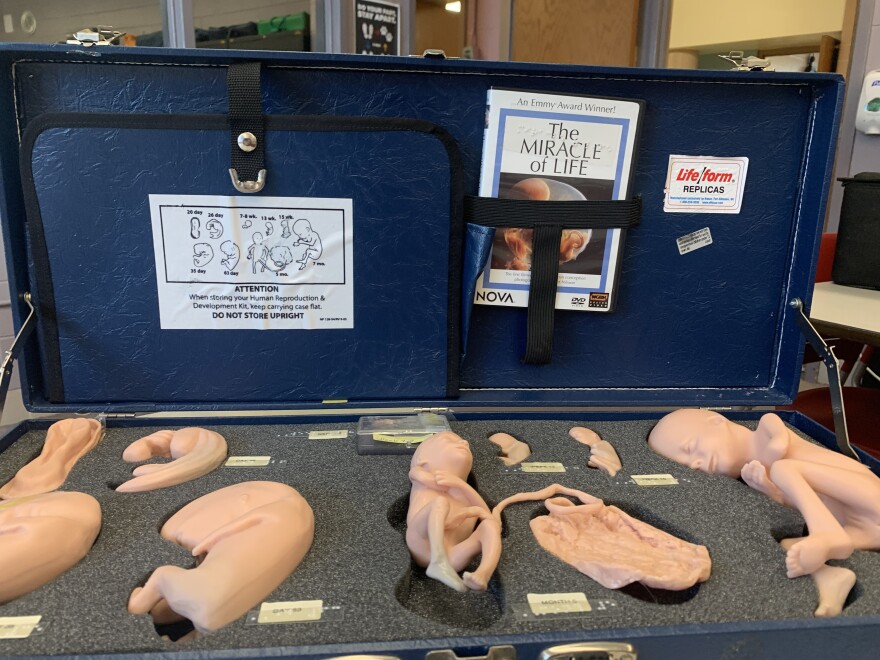Sex education is almost always taught visually. Students are given worksheets with diagrams of human anatomy and sex organs. They watch videos about the reproductive process. None of that helps blind students much at all.
Gaylen Kapperman is a professor emeritus at Northern Illinois University. He spent decades teaching in the college of education’s visual disabilities training program. Kapperman is also blind.
“It is extraordinarily unfair to have only blind youngsters totally ignorant about this, one of the major aspects of being a human being, that is, having sexual relationships,” he said.
Kapperman and NIU visual disabilities professor Stacy Kelly helped author a guidebook for teachers called “Health Education For Students With Visual Impairments” in 2019. Kelly says they conducted research asking visually-impaired adults to reflect on their sex education experiences.
“It does show that they did not have meaningful health education experiences," said Kelly. "They had to figure things out on their own, or they were misinformed or they misunderstood."
There are ways to teach sex education to visually-impaired students. But, Kapperman says, that’s where they start getting pushback. That’s because these methods include using anatomically-correct 3D models. There are tangible models of genitals, as well as other health processes like pregnancy. They have special kits to explain birth control and vasectomies, too.
Their research and other educators say it works. But, Kapperman says, the resistance educators who teach visually-impaired students get is about the genital models.
“Their supervisors who don't know anything about teaching blind youngsters forbid them to use these realistic models," he said, "because — we don't know for sure, but we think — these uninitiated, untrained individuals view this as pornography for the blind."
Kapperman says the models are necessary because visually-impaired people can’t fully interpret complex 3D objects like anatomy through audibly-explained videos or tracing their fingers along a raised outline of an image. That’s because it’s impossible to grasp the perspective of a 3D object from a 2D plane. Hence the models.

Professor Kelly also says access to health education is crucial because children with disabilities are far more likely to be sexually abused than their non-disabled peers.
“Really what it all boils down to is that knowledge is power," she said. "When our students who are visually impaired don't have access to that knowledge, they are less empowered, unfortunately, to no fault of their own.”
Teachers of visually-impaired students use a resource called the Illinois Instructional Materials Center to share often-expensive equipment and materials like braillers – machines similar to a typewriter for printing in Braille -- and accessibility software.
Kapperman says he’s been urging the Instructional Materials Center to purchase sex education models and kits. Greg Polman is the senior vice president of public policy at the Chicago Lighthouse, which operates the center. He says that they hadn’t heard much interest in the models until recently, but they are effective tools. The center hopes to purchase some kits -- which can cost over $4,000 each -- soon.
In Illinois, sex education still isn’t totally required even for sighted kids. But schools that teach comprehensive sex education now have to align their curriculum with national standards. The 2021 law mandating that is SB 818. It was criticized by Illinois Republicans and some Democrats. They claim it teaches students about certain sex concepts too soon.
The new law also says course material and instruction have to be accessible to students with disabilities. For visually-impaired students, they also have different, more simple, and age-appropriate kits for lower grade levels that include things like ragdolls to teach basic health concepts. The guidebook Kapperman and Kelly put together aligns with those new national standards.
The bottom line, Kapperman says, is that blind people have sex. It’s occurred to him that some people might be somehow uncomfortable with that and it could be evident in some of the pushback they get from teachers or administrators.
“'Why should blind people have sex? They're blind!' As a blind person, I resent that attitude a lot,” said Kapperman.
And he wants to make sure that visually-impaired students are just as prepared for it as their sighted peers
The new Illinois sex education standards go into effect during the 2022-23 school year.



